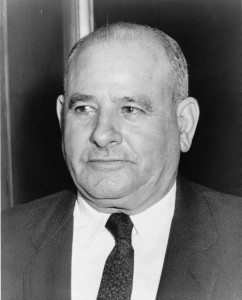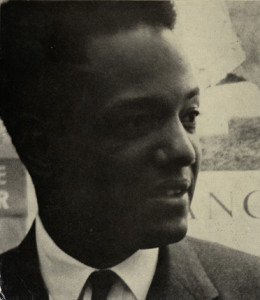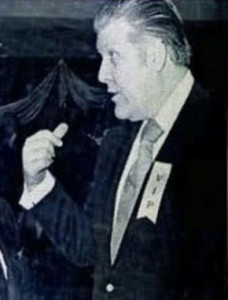Editor’s note: Friday, Nov. 22, is the 50th anniversary of the assassination of President John F. Kennedy.
Truth trickles out over time.
The Warren Commission, which probed the murder of President John F. Kennedy, pinned it all on Lee Harvey Oswald, a 24-year-old former Marine who worked at the Texas Book Depository, which overlooked Dealey Plaza, in Dallas, Texas.
Kennedy was killed by rifle fire on Friday, Nov. 22, 1963. Less than two days later, Oswald was shot to death in the basement of the Dallas police headquarters in front of dozens of cops, newsmen and an NBC-TV live camera.
While Oswald had maintained his innocence, there was no doubt who killed Oswald. It was a man well known to Dallas police: Jack Ruby, a local nightclub operator.
The Warren Commission ignored witnesses who testified that Ruby was connected to organized crime and involved in gun-running, narcotics and gambling. In 1979, the House Select Committee on Assassination presented that evidence. Ruby was tied directly to organized crime figures such as Santos Trafficante, in Havana; Nofio Pecora, in New Orleans; and Dominick Bartone, in Cleveland and Miami.
Then–in the mid-1990s, when the federal government declassified thousands of documents from the investigations–the extent of Ruby’s national and international contacts and his longtime status as a police informant became clearer.
Ties to Central New York
Two Syracuse gamblers with international aspirations. A stripper who danced at the Civic Follies. An eccentric pianist who lived in a Baldwinsville mansion. A Teamster who made deliveries to Central New York supermarkets. A Buffalo godfather who owned a funeral parlor. A Manhattan mobster who summered in upstate New York.
All rubbed elbows with key role players in the 1963 assassination of President John F. Kennedy. By choice or by chance, they found themselves immersed in the worlds of Jack Ruby, Jimmy Hoffa, Meyer Lansky, anti-Castro Cubans and unscrupulous Central Intelligence Agency employees.
Anthony “Mitzie” Tucci
The most intriguing Syracuse connection to the JFK hit involves two prominent Salt City gamblers investigated for brokering shadowy international deals with a close associate of Ruby.
Three years before Kennedy was killed in Dallas, Syracuse high-roller Anthony “Mitzie” Tucci hooked up with Cleveland organized crime figure Dominick E. Bartone to sell $22 million in pesos on the international market. FBI reports indicate that Bartone and Tucci also sold military equipment to Cubans, materiel such as rifles, jeeps, buses and airplanes.
One of Bartone’s partners on those deals was Ruby.
Mitzie Tucci–then 48 and living on Brattle Road, in Syracuse, while also listing an address on West Water Street–was identified in 1960 FBI reports as a “lifelong professional gambler.” He was one of several men, including Bartone, who were selling the pesos for Meyer Lansky. A legendary casino operator, Lansky lost his Cuban casinos when Fidel Castro overthrew Fulgencio Batista in 1959.
After Castro nationalized the island’s hotel-casinos and outlawed gambling, he essentially wiped out Lansky’s revenue streams. He lost millions.
To add insult to injury, Castro prohibited the circulation of Cuban pesos of 100 denomination or more. Piles of those bills had accumulated at Lansky gambling operations, such as the Hotel Nacional, Habana Riviera, the Deauville and the Montmartre Club.
“Castro canceled the currency in favor of a new issue, and anyone caught holding more than 100 Cuban pesos lost it,” wrote Andrew St. George. His article in April 1970 in True magazine reported on Lansky’s determined efforts to recoup his cash.
One of those efforts involved Tucci, who, according to the FBI, “contemplated flying to Venezuela, Dominican Republic and Switzerland relative to the afore-mentioned pesos and equipment negotiations.”
The phone in Tucci’s home on Brattle Road was tapped by the New York State Police. They heard him making arrangements with men in Florida regarding the pesos deal. In August and September 1959, troopers bugged Tucci’s hotel-room telephones at the Lexington Hotel, in New York City, and the Fontainebleau and Roney Plaza Hotel, both in Miami.
State Police Investigator Peter Rossomono, who was based in Syracuse, noted that Bartone, the Cleveland mobster, had been arrested May 22, 1959, by the U.S. Customs Bureau “for the illegal export of munitions of war” with exiled Cubans and Dominicans. By allying himself with Bartone, Tucci joined a shady international endeavor also involving Ruby.
The release of previously classified government documents in the 1990s have confirmed that Bartone did business with Ruby, although Ruby apparently used an alias: Jack LaRue.
Changed names were nothing new for Ruby. His birth name was Jacob Rubenstein, and he added a middle name, Leon, in 1940, before he and two of his brothers legally changed their names to Ruby in 1947. In his 1988 book Contract on America, author David Scheim reports that “Jack Rubenstein” was listed by the State Department and Army Intelligence among recognized arms dealers.
Not only was Bartone tied to Lansky in the pesos deal–which also involved Tucci and another Syracusan, Sam Silver–Bartone knew Tampa/Havana gangster Don Santos Trafficante. When Bartone and Ruby visited Havana to confer with soldier-of-fortune William Morgan and Cuban exile leader Eloy Menoyo, they stayed at Trafficante’s Capri Hotel. The hotel’s guest records from 1959 remained top secret for three and a half decades.
In 1966, Tucci’s brother Dominick died in Syracuse. In the obituary, Mitzie Tucci’s residence was listed as “South America.”
Samuel Silver
On April 23, 1960, The Post-Standard ran a double-deck front-page, all-caps headline:
“UNMASK SYRACUSAN AS GAMBLING KINGPIN”
That kingpin was Sam Silver, “a well-known Syracuse bookie” who testified on April 22 before the State Investigative Commission in New York City.
Outfitted in a gray, herringbone suit and alligator loafers, Silver admitted that in December 1959 he met in a Manhattan hotel with a “Mr. Prior” to discuss Lansky’s $22 million in Cuban pesos. Silver said he hoped to get “12 or 13 cents on the dollar” for the troubled currency. Silver, who was born in Poland in 1908, acknowledged that he knew Lansky.
During his second day of testimony, Silver said the pesos sale “fell through.”
Although he firmly denied taking part in any munitions deals, Silver told the commission that in September 1959 Tucci had discussed selling buses to Venezuela, the Dominican Republic or Cuba. Silver practically begged the commission to absolve him of any hint of criminality.
“Don’t put my activities in organized crime,” he said. “Don’t make me a member of any syndicate. I’m just a bettor. I’m just an individual.”
On May 6, 1960, FBI Special Agent George P. Simpson filed a report citing New York State Police information that Tucci and Silver were working on Lansky’s pesos deal. Subsequent FBI reports filed at Simpson’s Albany office note that Silver, who lived at 120 Gray Ave., Syracuse, aided Tucci in his dealings with Bartone.
Like Silver–who also had residences in Rochester, New York City and Montreal–Bartone ran businesses in Ohio, Florida and Panama. In Cleveland, he did business with Louis “Babe” Triscaro, a top official of the Ohio Conference of Teamsters.
Bartone’s pal, Ruby, shared an interest in the Teamsters. Two weeks before Kennedy’s murder, Ruby chatted at length over the phone with Jimmy Hoffa’s 6-foot-6 bodyguard, former boxer Barney Baker. When Baker testified before the House and Senate Committee on Assassinations on May 23, 1978, he admitted that Hoffa knew Bartone and Triscaro.
Joe Cataldo
Ruby’s telephone bills in 1963 reveal a long-distance call made July 7, 1963, to Gloversville, a town of 15,000 in Fulton County, 35 miles northwest of Albany.
At first, investigators assumed the call was placed by Ruby’s roommate, George Senator, who was raised in Gloversville, where his family owned a restaurant. But when the FBI traced the call, the feds found that the phone number belonged to Joe Cataldo.
The owner of Chandler’s Restaurant, on East 49th Street, Cataldo was a made member of the Genovese family. Manhattan Mafia Guide, by Eric Ferrara, identifies Cataldo as “a major racketeer, loan shark, casino manager, nightclub owner and entertainment biz mover and shaker.”
Ruby’s July call rang at Cataldo’s summer getaway, in Gloversville. Although an FBI informant claimed that Ruby booked talent for his Dallas nightclubs through Cataldo, Cataldo denied it. When the G-men showed Cataldo a photo of Ruby on Dec. 11, 1963, Cataldo insisted he didn’t recognize the man.
Whether Cataldo knew Ruby by sight, Cataldo had clearly set his sights on a popular upstate horse-racing facility: the Finger Lakes Racetrack, in Canandaigua, 22 miles south of Rochester.
In a 1972 article, Sports Illustrated documented Cataldo’s interest in Canandaigua’s thoroughbred track. That year, Cataldo testified before a congressional committee probing organized crime in sports and admitted that he’d expected to earn a $100,000 “finder’s fee” if he could locate a squeaky-clean front man acceptable to the state Racing Commission to run the track.
In his testimony, Cataldo admitted that he knew Trafficante and Lansky in Cuba and owned shares of Trafficante’s Havana Capri.
In 1968, Cataldo was indicted for stock fraud. In 1980, he was accused of plotting to sabotage a drug-smuggling trial in Miami, a plot that included the planned murder of a federal judge.
Stefano “The Undertaker” Magaddino

In a telephone call recorded by the FBI on Oct. 31, 1963, three weeks before the assassination, Maggadino profanely complained to his son, Peter, about the way Attorney General Robert F. Kennedy was prosecuting the Mafia.
“He should drop dead,” Maggadino said. “They should kill the whole family, the mother and father, too.”
Naturally, as the Mafia’s top man in Buffalo, Maggadino’s tentacles reached deeply into Central New York. His financial consigliere, Vincent Scro, was the son of Syracuse businessman Salvatore “Sam” Scro, owner of the Darling ice cream company, at North State and Ash streets. Maggadino was godfather to one of Scro’s daughters.
Maggadino and Scro both did business with beer and soda bottler Joe Barbara, who hosted the most famous Mafia conclave ever in November 1957 at his country estate in Apalachin on the border between New York and Pennsylvania. Maggadino’s brother, Nino, was one of a half-dozen hoods from Western New York who were arrested at the conference. Barbara was the Maggadino brothers’ cousin.
Apalachin had added fuel to Bobby Kennedy’s fire. As chief counsel to the McLennan Committee investigating Improper Activities in the Labor Field nationwide, in July 1958 RFK publicly identified Syracuse’s Scro family and Darling Ice Cream and their connections to Barbara and Maggadino.
However strong they were, Maggadino’s local connections paled in comparison to his connections to major mob drug traffickers from Manhattan, Montreal and Texas. A month before Apalachin, Nino had attended a Mafia conference in Sicily regarding the international distribution of narcotics.
Five years before the president’s murder, Federal Bureau of Narcotics agent Jack Cusack–who made his bones busting drug dealers in New York City before becoming the FBN’s district supervisor in Atlanta–told the McClellan Committee that Maggadino supplied heroin to Joe Civello, in Dallas. The link between Maggadino and Civello, Cusack said, was New York City gangster “Big John” Ormento, who had managed narcotics for the Thomas Lucchese family since 1942.
After the assassination, Civello said he visited Ruby’s nightclubs. Civello, who answered to Carlos Marcello, had also befriended Dallas Police Sgt. Patrick Dean, who oversaw security in the Dallas Municipal Building basement on the morning Ruby shot Oswald.
Robert Pritchard

On April 7, 1975, investigative journalists Jack Anderson and Les Whitten reported in their syndicated column, Washington Merry-Go-Round, that Pritchard had testified in secret before the Rockefeller Commission, which was probing CIA “executive action,” a euphemism for the killing of foreign leaders.
They reported that Pritchard testified about two attempts on Duvalier’s life. In one, he was recruited to poison Duvalier’s food. He said he declined to participate and told Duvalier about the plot.
Many who have studied the JFK assassination theorize that U.S. support for political killings in the Caribbean were linked to Kennedy’s murder in Dallas.
Julie Taylor
The FBI investigated both the Kennedy and Oswald killings. The probe stretched all the way to Syracuse, where two G-men interviewed entertainer Julie Taylor here on Dec. 2, 1963.
Taylor, a striptease dancer, and her husband, comedian/emcee Ricky Case, had worked for Ruby’s Carousel Club in July and August 1962. In November 1963, Taylor accepted a job to take off her clothes at the Civic Follies, 572 S. Salina St. She was billed here as “the body sublime.”
The Follies featured four stage shows daily plus comedians and adult films, and Syracuse pianist Vincent Falcone accompanied dancers there in 1963. In his autobiography, Frankly, Just Between Us, co-written by Bob Popyk, Falcone recalls working with a drummer 10 a.m. to 10 p.m. six days a week.
“{We were} playing the worst music you could imagine,” he wrote, “although there were obvious visual benefits.”
Falcone, who later became Frank Sinatra’s musical director, was working at the Civic Follies, and so was Julie Taylor, the day Kennedy was killed.
Many of the gals who danced at places like Ruby’s club and the Civic Follies worked a circuit that would have them booked for a week or so at a time. Ruby’s girls often worked at joints in New Orleans, Houston, Tulsa, Wichita and Oklahoma City. Just before appearing in Syracuse, Taylor had performed in New York City.
Taylor didn’t have much to tell the agents when they paid her a visit backstage at the Civic Follies, but she made note of Ruby’s mercurial temperament.
Frank “The Irishman” Sheeran

During World War II, Sheeran had served in the Army infantry in Italy. As a result of his service, Sheeran spoke conversational Italian, which impressed the Good Samaritan. The men hit it off, and the older guy turned out to be Russell Bufalino, Mafia boss of Eastern Pennsylvania and New York’s Southern Tier.
Dubbed “The Irishman” by his new Italian-American friends, Sheeran combined his aptitude for violence and his position in the International Brotherhood of Teamsters to become a valued asset and best buddy to both Bufalino and Jimmy Hoffa.
In a posthumous memoir, I Heard You Paint Houses, Sheeran notes that “perhaps Bufalino’s closest friend was Philadelphia crime boss Angelo Bruno.” Bruno, who got whacked in 1980, was a cousin of Dominick Bruno, longtime impresario at Three Rivers Inn, in Phoenix.
During his lengthy career of loan-sharking, labor racketeering and body-guarding, Sheerran got to know prominent Mafiosi such as Sam Giancana, Carlos Marcello and Trafficante, and he met Lansky.
Sheeran also met Jack Ruby.
“Once in a while, Giancana would have a guy with him named Jack Ruby from Dallas,” Sheeran wrote. “I met Jack Ruby a few times. I know Jimmy {Hoffa’s} kid met him, too, at the Edgewater. Ruby was with Giancana and he was with {Chicago labor leader} Red Dorfman. One time we all went out to eat, and Ruby had a blonde with him that he brought up from Dallas for Giancana. There’s no doubt whatsoever that Jimmy Hoffa didn’t just meet Jack Ruby, he knew Jack Ruby, and not just from Giancana, but from Red Dorfman, too.”
In November 1963, Bufalino asked Sheeran to deliver a duffel bag to Baltimore, where he handed it over to David Ferrie, a pilot for Marcello.
“You didn’t have to spend all that time in combat to know you had a duffel bag with three rifles in it,” he wrote. “I knew it was rifles, but I had no idea what it was.”
In his 2004 book co-written by attorney Charles Brandt, The Irishman, Sheeran claims he received the rifles at Monte’s Restaurant, in South Brooklyn, from Genovese caporegime Tony Provenzano. Sheeran drove them to Campbell’s Cement, in Baltimore, where he delivered them to Ferrie and a man from the Genovese mob.
After Kennedy was assassinated, Sheeran wondered if he had handled the weapons that killed him.
“Even before Ruby whacked Oswald, it crossed my mind whether it had anything to do with that matter at Monte’s,” he wrote. “I don’t have to tell you there was nobody you could ask about something like that.”
Russ Tarby will participate in the 20th annual JFK Lancer November in Dallas Conference, Thursday, Nov. 21, to Sunday, Nov. 24. He’ll conduct a public interview with former Carousel Club stripper Tammi True at the Adolphus Hotel on Nov. 24, the 50th anniversary of Jack Ruby’s murder of Lee Harvey Oswald.


